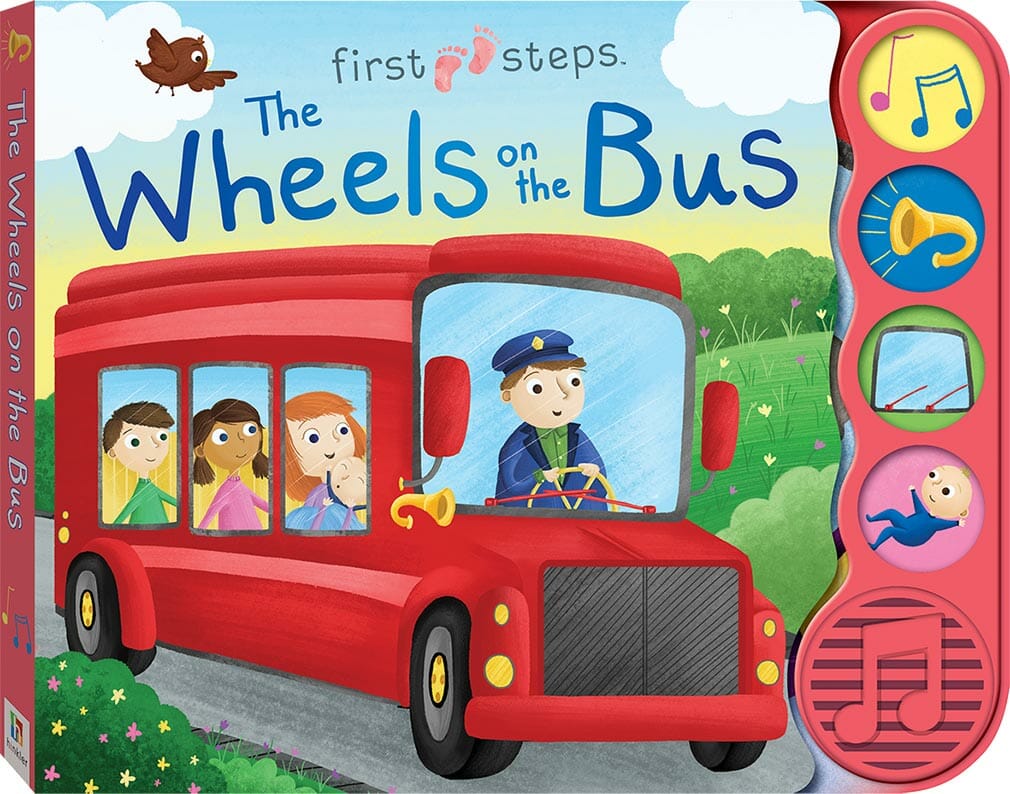
The wheels on the bus lyrics
The wheels on the bus go ’round and ’round,
‘Round and ’round, ’round and ’round,
The wheels on the bus go ’round and ’round,
All through the town.
The wipers on the bus go swish, swish, swish,
Swish, swish, swish, swish, swish, swish,
The wipers on the bus go swish, swish, swish,
All through the town.
The horn on the bus goes beep, beep, beep,
Beep, beep, beep, beep, beep, beep,
The horn on the bus goes beep, beep, beep,
All through the town.
The doors on the bus go open and shut,
Open and shut, open and shut,
The doors on the bus go open and shut,
All through the town.
The driver on the bus says, “Move on back,
Move on back, move on back,”
The driver on the bus says, “Move on back,”
All through the town.
The babies on the bus go “Wah, wah, wah,”
“Wah, wah, wah, wah, wah, wah,”
The babies on the bus go “Wah, wah, wah,”
All through the town.
The mommies on the bus go, “Shh, shh, shh,”
“Shh, shh, shh, shh, shh, shh,”
The mommies on the bus go, “Shh, shh, shh,”
All through the town.
The daddies on the bus go, “I love you,”
“I love you,” “I love you,”
The daddies on the bus go, “I love you,”
All through the town.
The people on the bus go up and down,
Up and down, up and down,
The people on the bus go up and down,
All through the town.
The money on the bus goes clink, clink, clink,
Clink, clink, clink, clink, clink, clink,
The money on the bus goes clink, clink, clink,
All through the town.
The driver on the bus says, “Faster, faster!”
“Faster, faster, faster, faster, faster!”
The driver on the bus says, “Faster, faster!”
All through the town.
The wheels on the bus go ’round and ’round,
‘Round and ’round, ’round and ’round,
The wheels on the bus go ’round and ’round,
All through the town.
The wheels on the bus lyrics history
“The Wheels on the Transport,” is an American society melody composed by Verna Slopes (1898-1990). Verna Slopes was a lyricist and writer known for her commitments to youngsters’ music. She is credited with making the tune, which has turned into a darling and notable nursery rhyme.
While the specific subtleties of the tune’s creation and early history probably won’t be broadly recorded, it is generally perceived that Verna Slopes assumed a critical part in its piece. “The Wheels on the Transport” was probable written during the twentieth hundred years, and its ubiquity has persevered for quite a long time.
The tune’s energetic and dreary nature makes it especially interesting to small kids, and its portrayal of different transport related activities and sounds adds an intuitive and connecting with component. Over the long haul, the melody has been adjusted and recorded by different craftsmen, and it has turned into a staple in youth training, kids’ diversion, and family sing-alongs.
“The Wheels on the Transport” keeps on being esteemed by ages of kids and stays a central piece of the collection of tunes used to instruct and engage small children.
Who Wrote the Wheels on The Bus Nursery Rhyme?
“The Wheels on the Transport” is an American society tune, and its initiation is frequently credited to Verna Slopes (1898-1990), a lyricist and writer. While the specific subtleties of its creation and early history probably won’t be broadly archived, Verna Slopes is generally perceived for her commitment to the tune’s arrangement. The tune has since turned into a well known and getting through nursery rhyme, treasured by ages of youngsters.
Why was The Wheels on the Bus written?
“The Wheels on the Transport” was possible composed as a lively and drawing in tune for small kids. The tune’s basic song, tedious design, and clear portrayal of different activities and sounds on a transport ride make it interesting to youthful audience members. Melodies like “The Wheels on the Transport” are frequently made to catch kids’ consideration, empower their support, and help in their improvement of language abilities, coordinated movements, and cadence. It’s likewise a method for acquainting kids with regular ideas and encounters in an engaging way. While the specific justification for its creation probably won’t be recorded, obviously the melody has turned into a dearest and notable piece of kids’ music and culture.
What Do Swish and Vroom Mean?
“Swish” and “vroom” are onomatopoeic words that imitate sounds.
- Swish: “Swish” is an onomatopoeic word that mimics the sound of something moving quickly through the air or water, creating a soft, hissing sound. In the context of “The Wheels on the Bus,” the wipers on the bus go “swish, swish, swish,” which suggests the motion of the wipers clearing rain or debris from the windshield.
- Vroom: “Vroom” is an onomatopoeic word often used to imitate the sound of a vehicle’s engine revving or running at a high speed. In the song, the sound of the horn on the bus goes “beep, beep, beep,” but the use of “vroom” is not present in the traditional lyrics.
Both of these words are commonly used in children’s songs and literature to create vivid and engaging descriptions that help children connect with the actions or sounds being depicted.
The wheels on the bus lyrics
What Does This Song Teach Children?
“The Wheels on the Transport” is a well known kids’ tune that offers a few instructive and formative advantages for little youngsters:
Language Improvement: The tune opens youngsters to an assortment of jargon connected with transportation and ordinary activities, for example, “wheels,” “horn,” “wipers,” “entryways,” and that’s only the tip of the iceberg. Rehashing the verses assists youngsters with learning new words and build up their language abilities.
Cadence and Tune: The tune has a basic and infectious song with a dreary construction, which assists kids with fostering a comprehension of mood and melodic examples. Chiming in and applauding to the beat can improve their ability to keep in tempo and timing.
Coordinated movements: The melody’s intelligent nature urges kids to take part in actual activities, for example, claiming to turn a guiding wheel, moving their hands like wipers, or making a “blare” sound like a horn. These activities assist with growing fine and gross coordinated movements.
Creative mind and Innovativeness: As youngsters draw in with the tune’s activities and sounds, they utilize their minds to imagine being on a transport ride and copy different transport related activities. This cultivates inventiveness and innovative play.
Listening Abilities: Paying attention to the verses and tracking with the activities assists youngsters with fostering their listening abilities and the capacity to adhere to guidelines.
Social Connection: Singing the melody in a social environment, for example, a homeroom or family gathering, energizes social collaboration, collaboration, and gathering support.
Social Proficiency: “The Wheels on the Transport” is a notable and conspicuous tune, and being know all about such social references is a significant part of social education.
Instructive Commitment: Educators and guardians frequently utilize the tune as a tomfoolery and connecting method for presenting or support different ideas, like transportation, activities, and regular schedules.
The wheels on the bus lyrics
The wheels on the bus lyrics
Twinkle twinkle little star lyrics
The Wheels on the Bus questions and answers
Q1: Who wrote “The Wheels on the Bus”?
“The Wheels on the Bus” is an American folk song, and its authorship is often attributed to Verna Hills (1898–1990), a songwriter and composer.
Q2: When was “The Wheels on the Bus” first published?
The earliest known publishing of the lyrics of “The Wheels on the Bus” is in the December 1937 issue of “American Childhood” magazine.
Q3: What are the main actions and sounds described in the song?
The song describes various actions and sounds that occur on a bus ride, such as the wheels going round and round, the wipers going swish, the horn going beep, the doors opening and shutting, and more.
Q4: What is the significance of “All through the town” in the song?
“All through the town” is a repeated line at the end of each verse that emphasizes the bus’s movement and the actions happening as it travels through the town.
Q5: How is “The Wheels on the Bus” used in early childhood education?
The song is often used to engage young children in interactive and educational activities. It helps develop language skills, rhythm, and motor skills as children mimic the actions described in the song.
Q6: Are there different variations of the song’s lyrics?
Yes, there are variations in the lyrics of “The Wheels on the Bus” depending on regional differences and adaptations. Some versions might include additional verses or slightly different wording.
Q7: Has “The Wheels on the Bus” been recorded by different artists?
Yes, the song has been recorded by numerous artists and has appeared in various children’s music albums and media.
Q8: What is the appeal of “The Wheels on the Bus” to young children?
The song’s repetitive and playful nature, along with its simple and catchy melody, makes it appealing to young children. The interactive actions and familiar sounds create an engaging and enjoyable experience for them.
Q9: Are there any adaptations or spin-offs of the song?
Yes, over the years, there have been adaptations and spin-offs of “The Wheels on the Bus” that incorporate different themes or variations of the original lyrics.
Q10: What role does “The Wheels on the Bus” play in children’s culture?
“The Wheels on the Bus” is a beloved and iconic children’s song that has become a cultural touchstone in early childhood education and entertainment. It is often sung and performed in various settings, such as schools, daycare centers, and family gatherings.
The wheels on the bus lyrics The wheels on the bus lyrics The wheels on the bus lyrics The wheels on the bus lyrics The wheels on the bus lyrics The wheels on the bus lyrics The wheels on the bus lyrics The wheels on the bus lyrics The wheels on the bus lyrics The wheels on the bus lyrics The wheels on the bus lyrics The wheels on the bus lyrics



